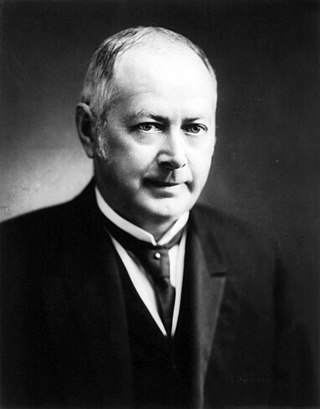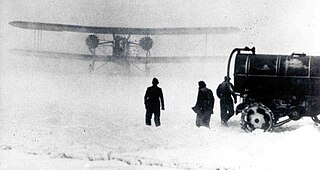
The United States Post Office Department was the predecessor of the United States Postal Service, established in 1792. From 1872 to 1971, it was officially in the form of a Cabinet department. It was headed by the postmaster general.

The Curtiss JN "Jenny" was a series of biplanes built by the Glenn Curtiss Aeroplane Company of Hammondsport, New York, later the Curtiss Aeroplane and Motor Company. Although the Curtiss JN series was originally produced as a training aircraft for the US Army, the "Jenny" continued after World War I as a civilian aircraft, as it became the "backbone of American postwar [civil] aviation".

Glenn Hammond Curtiss was an American aviation and motorcycling pioneer, and a founder of the U.S. aircraft industry. He began his career as a bicycle racer and builder before moving on to motorcycles. As early as 1904, he began to manufacture engines for airships. In 1908, Curtiss joined the Aerial Experiment Association, a pioneering research group, founded by Alexander Graham Bell at Beinn Bhreagh, Nova Scotia, to build flying machines.

Airmail is a mail transport service branded and sold on the basis of at least one leg of its journey being by air. Airmail items typically arrive more quickly than surface mail, and usually cost more to send. Airmail may be the only option for sending mail to some destinations, such as overseas, if the mail cannot wait the time it would take to arrive by ship, sometimes weeks. The Universal Postal Union adopted comprehensive rules for airmail at its 1929 Postal Union Congress in London. Since the official language of the Universal Postal Union is French, airmail items worldwide are often marked Par avion, literally: "by airplane".

An airmail stamp is a postage stamp intended to pay either an airmail fee that is charged in addition to the surface rate, or the full airmail rate, for an item of mail to be transported by air.
This is a list of aviation-related events from 1934:
This is a list of aviation-related events from 1920:
This is a list of aviation-related events from 1919:

Albert Sidney Burleson was a progressive Democrat who served as United States Postmaster General and Representative in Congress. He was a strong supporter of William Jennings Bryan and Woodrow Wilson and so Wilson appointed him to the cabinet role heading the US Post Office. He expanded parcel post, rural free delivery, and air mail service. After America entered World War I in 1917, he stopped the mail delivery of anti-war publications and clamped down on free speech, actions that have been heavily criticized ever since.
The Air Commerce Act of 1926 created an Aeronautic Branch of the United States Department of Commerce. Its functions included testing and licensing of pilots, certification of aircraft and investigation of accidents.

Varney Air Lines was an American airline company that started service on April 6, 1926, as an airmail carrier. Formed by Walter Varney, the airline was based in Boise, Idaho, United States. The airline is one of the predecessors of United Airlines.

The Air Mail scandal, also known as the Air Mail fiasco, is the name that the American press gave to the political scandal resulting from a 1934 congressional investigation of the awarding of contracts to certain airlines to carry airmail and the subsequent disastrous use of the U.S. Army Air Corps to fly the mail after the contracts were revoked.

The Airco DH.4 is a British two-seat biplane day bomber of the First World War. It was designed by Geoffrey de Havilland for Airco, and was the first British two-seat light day-bomber capable of defending itself.
National Air Transport was a large United States airline; in 1930 it was bought by Boeing. The Air Mail Act of 1934 prohibited airlines and manufacturers from being under the same corporate umbrella, so Boeing split into three smaller companies, one of which is United Airlines, which included what had been National Air Transport.

United States airmail was a service class of the United States Post Office Department (USPOD) and its successor United States Postal Service (USPS) delivering air mail by aircraft flown within the United States and its possessions and territories. Letters and parcels intended for air mail service were marked as "Via Air Mail", appropriately franked, and assigned to any then existing class or sub-class of the Air Mail service.

James Herbert "Jack" Knight was an American pilot who made the first overnight transcontinental air mail delivery. Knight was part of an airmail relay team that flew 2,629 miles across the United States on February 22–23, 1921 in an effort to show that the airmail service was much faster than the railroads. When all the other pilots were weathered-in or broken-down, Knight flew extra relay sections through the night in snow and fog and is credited with saving the airmail service from political decommission. "Jack Knight's Night Flight" made him the most famous pilot in America in the era prior to Charles Lindbergh.

Otto Praeger was the Washington, D.C., postmaster from 1913 to 1915 and was the Second Assistant United States Postmaster General from 1915 to 1921. He was responsible for implementing airmail from 1918 to 1927.

In aerophilately, a branch of philately, a first flight cover, also known by the acronym FFC, is mail that has been carried on an inaugural flight of an airline, route, or aircraft, normally postmarked with the date of the flight often of the arrival destination proving it was actually carried on the aircraft and may have a special flight cachet and/or an arrival postmark. Because many first flight covers are essentially made as collectables they can be considered philatelic mail though others consider them to be postal history.

Dean Cullen Smith was a pioneer American mail pilot, test pilot, flying instructor, Antarctic pilot, and airline pilot. At 17 years of age, he became the youngest flight instructor in U.S. Army history. He was a lead pilot for the U.S. Postal Service's airmail service, and was the first pilot to initiate night air mail flights. He was an executive for many airlines and aircraft companies.
Clifford Ball was an American farmer, soldier, bookkeeper, clerk, automobile dealer, airplane dealer, airline owner, airline operator, airline executive, radio manufacturer, Civil Air Patrol officer and chaplain, and aviation pioneer.














